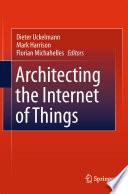Converging Technologies for Smart Environments and Integrated Ecosystems
The book aims to provide a broad overview of various topics of the Internet of Things (IoT) from the research and development priorities to enabling technologies, architecture, security, privacy, interoperability and industrial applications. It is intended to be a stand-alone book in a series that covers the Internet of Things activities of the IERC - Internet of Things European Research Cluster - from technology to international cooperation and the global "state of play." The book builds on the ideas put forward by the European Research Cluster on the Internet of Things Strategic Research and Innovation Agenda and presents views and state of the art results on the challenges facing the research, development and deployment of IoT at the global level. Today we see the integration of Industrial, Business and Consumer Internet which is bringing together the Internet of People, Internet of Things, Internet of Energy, Internet of Vehicles, Internet of Media, Services and Enterprises in forming the backbone of the digital economy, the digital society and the foundation for the future knowledge and innovation based economy. These developments are supporting solutions for the emerging challenges of public health, aging population, environmental protection and climate change, the conservation of energy and scarce materials, enhancements to safety and security and the continuation and growth of economic prosperity. Penetration of smartphones and advances in nanoelectronics, cyber-physical systems, wireless communication, software, and Cloud computing technology will be the main drivers for IoT development. The IoT contribution is seen in the increased value of information created by the number of interconnections among things and the transformation of the processed information into knowledge shared into the Internet of Everything. The connected devices are part of ecosystems connecting people, processes, data, and things which are communicating in the Cloud using the increased storage and computing power while attempting to standardize communication and metadata. In this context, the next generation of Cloud computing technologies will need to be flexible enough to scale autonomously, adaptive enough to handle constantly changing connections and resilient enough to stand up to the huge flows of data that will occur. In 2025, analysts forecast that there will be six devices per human on the planet, which means around 50 billion more connected devices over the next 12 years. The Internet of Things market is connected to this anticipated device growth from industrial Machine to Machine (M2M) systems, smart meters and wireless sensors. Internet of Things technology will generate new services and new interfaces by creating smart environments and smart spaces with applications ranging from Smart Cities, Smart Transport, Buildings, Energy, Grid, to Smart Health and Life.
The book aims to provide a broad overview of various topics of the Internet of Things (IoT) from the research and development priorities to enabling technologies, architecture, security, privacy, interoperability and industrial applications ...










